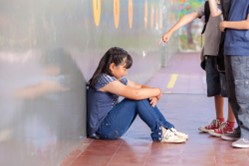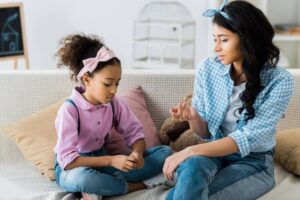My Kid Is Getting Bullied
What is bullying and why does it happen?
If your perspective on bullying was influenced by Hollywood, you may picture a bully as a snobby teen or a menacing neighbor kid. In our day-to-day lives, however, there are many forms of bullying and bullies can be coworkers, family members, and even people we consider friends.
Though bullies exist in adulthood, bullying among children is particularly concerning. According to StopBullying.Org, a site dedicated to addressing childhood bullying among kids, childhood bullying is described as “unwanted, aggressive behavior among school aged children that involves a real or perceived power imbalance” (What Is Bullying, 2022). Bullying can be understood through two main identifiers:
- There’s an imbalance of power: the bully is seen as bigger, stronger, more socially connected, or better resourced than the target or victim of bullying.
- It is repetitive: the unwanted behavior keeps happening, despite objections or efforts for it to stop.
Keep in mind that the power imbalance inherent in bullying can be real or perceived. A child others consider non-threatening can be seen as threatening to the person they are targeting.
It is also important to note that bullying isn’t just interpersonal conflict. It happens within a community and can be influenced or extinguished through community awareness and action.
The following image helps demystify bullying. It comes from the work of Dan Olweus, the late psychologist and bully prevention researcher and advocate. Olweus’ circle describes the link between the bully, the target, and those who watch, participate in, or resist the behavior.
(Olweus, 2012)
As you consider this visual, think of a time you were part of a bullying circle. Maybe you haven’t been a target, but you have almost certainly experienced one of the other roles. The good news is this: anyone can learn to be a resistor and defender (described by the letter “G”).
Another word for a resistor or defender is “upstander”. Upstanders notice bullying and speak up for the target. If afraid of physical or social repercussions, they seek help from someone who can address the problem. Bullying exists when no one is aware of it or those who are aware participate or ignore it.

Where does bullying happen?
Since kids spend most of their time in school, we tend to think of bullying as a school problem. In reality, bullying happens wherever people are, and opportunities for bullying exist in a variety of settings including online, during after school activities, and within families. With the advent of multi-player video games and social media, bullying tends to move between online and in-person interactions.
For children who struggle to vocalize that they’re being bullied, warning signs of bullying can include:
- A sudden loss of interest in school or change in academic performance
- Frequent complaints of physical illness that weren’t present before
- Avoidance of social situations and activities with peers–refusing to go to school, attend after school activities, or spend time with peers
- Changes in sleep, appetite, and activity levels
It’s important to note that these signs aren’t unique to childhood bullying and could point to a number of other challenges. If you suspect your child is struggling, talking with them is the first step (Stomp Out Bullying, n.d.).
How to talk with your child about bullying:
Bullying tends to bring up feelings of shame and inadequacy. Because of this, I encourage adults to have regular, non-judgmental conversations about friendships, peers, and bullying.
Here are some conversation starters:
- Tell me about your class.
- What is your teacher like?
- Who do you spend time with during the day?
- Is there anyone you don’t get along with?
- What do you like about your friends?
- When your friends do or say things you don’t like, what can you do?
- Do you notice kids who are being bullied? How can you help?
- When you need help and don’t know what to do, what adults can you talk to?
Have these conversations during neutral times (i.e. not when your child is upset, hungry, or exhausted). If your child says something that activates your protective parent nerves, check-in with yourself before responding.
If we respond to bullying with anger or threats of violence, we send the message that conflict can only be solved by causing harm to the aggressor. While it’s natural to want revenge in moments where we feel powerless, causing harm to someone else isn’t the answer.
When your protective parent mode is on full blast, remind yourself of this question:
If the problem solving skills we are teaching children now would lead to legal involvement or job termination in the future, is this the best way to handle the situation? If the answer is no, give yourself some time to cool down before offering suggestions.
What to do if your child is being bullied:
Bullying isn’t a big scary monster that can’t be defeated. Bullying is a community issue that can and must be addressed. Here are some things to consider and action steps to take if your child is being bullied:
Things to consider
- Is the behavior repeated?
- Does it keep happening, despite your child asking for help from an adult or telling the bully to stop?
- Or, does your child feel powerless to ask for help when the bullying occurs?
- Where is it happening?
- When is it happening
- What time of day does it occur?
- Who is around?
- Who is not around when it happens?
- What has been your child’s response to the bullying, up until now?
- Where does your child feel empowered, competent, and worthwhile?
- As much as possible, increase their time in the settings and with people where they feel their best
How to proceed
- Instill hope in your child. This is the first, and perhaps most important, step. Bullying can and will stop when we address it
- Teach your child how bullying works and why it continues. Remember that knowledge is power and raising awareness of bullying helps cultivate more safe environments. You can use the “Bullying Circle” visual included with this blog to start the conversation.
- Remind your child that bullies are only bullies because they think they are in charge. The only person in charge of how we feel about ourselves is the person living our life… us!
- Empower your child to speak up for others when they see bullying.
- Teach your child a simple three step process called “Stop, Walk, and Talk” (pictured below).
- Though a child may feel powerless to stand up to someone bullying them, their confidence builds as they learn to stick up for others.
- Notify school staff or trusted adults who can step in or offer support if your child is being bullied in a place where you aren’t. This includes adults at school, friends’ houses, and at extracurricular activities.
- Follow up with your child
- Efforts to stop bullying take time. Plan regular intervals where you’ll check-in with your child until the situation is resolved

Stop, Walk, and Talk (PBIS World, 2023)
How to handle relational aggression
The bully who spreads gossip, starts rumors, or tries to turn others against your child may not leave visible evidence but their impact is just as significant, especially at a developmental stage where approval from peers is so important to kids’ self-image. This kind of bullying behavior is called relational aggression. It can happen at any age, though it tends to reach its peak in middle and high school. Because it damages relationships and can erode one’s sense of self, it’s critical to recognize when it’s happening and respond right away. Here are some ways to help your tweens and teens navigate relational aggression:
- Help your child recognize the difference between real friends and fake friends.
- Real friends are trustworthy, enjoyable to be around, and respect our boundaries.
- Fake friends can look like real friends, however, they don’t respect our boundaries and leave us feeling hurt and confused rather than loved and accepted.
- Remind your child that relational aggression is about power and control- the bully often thinks the only way to feel good about themselves is to put others down.
- Encourage your child to pursue activities and relationships that add to their lives.
Bully Free Communities
Though bullying exists in our communities, it doesn’t have to. As we teach kids to recognize bullying and act against it, we are creating a generation of upstanders. As we help children find their voice, we teach them that empowerment comes from finding that voice, not silencing or causing harm to someone else.
If you or your child need support (either responding to bullying or recovering from its affects) reach out to a school counselor or trained mental health professional. Together we can heal from bullying and build communities that are safe, respectful, and supportive.
Blog written by Sentier therapist, Lily Ferreira, MSW, LICSW

References
Home Bullying What Is Bullying. (2022, June 30). StopBullying.gov. Retrieved January 26, 2023, from https://www.stopbullying.gov/bullying/what-is-bullying
Olweus, D. (2012, April 13). As ‘Bully’ Opens, the Bullied, Bullies and Bystanders Weigh In. PBS. Retrieved January 26, 2023, from https://www.pbs.org/newshour/education/as-bully-opens-bullies-bullied-and-bystanders-weigh-in
PBIS World. (2023). Bullying Resources / Bullying Resources. Nassau County School District. Retrieved January 26, 2023, from https://www.nassau.k12.fl.us/domain/1155
Stomp Out Bullying. (n.d.). Signs Your Child Is Being Bullied – Tip Sheet. STOMP Out Bullying. Retrieved January 26, 2023, from https://www.stompoutbullying.org/tip-sheet-signs-your-child-being-bullied
This blog was written by Sentier therapist, Lily Ferreira, MSW, LICSW












